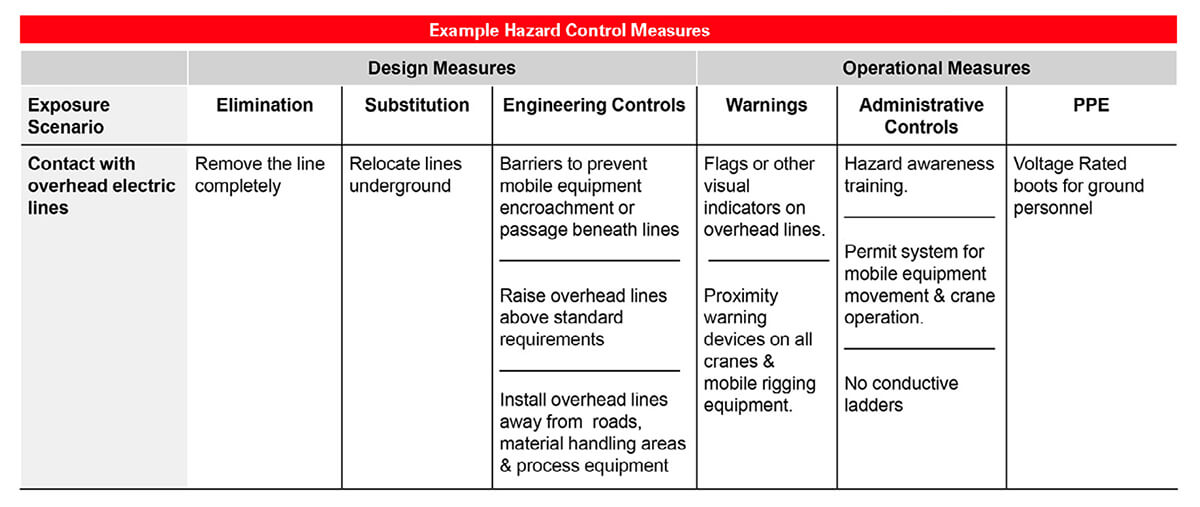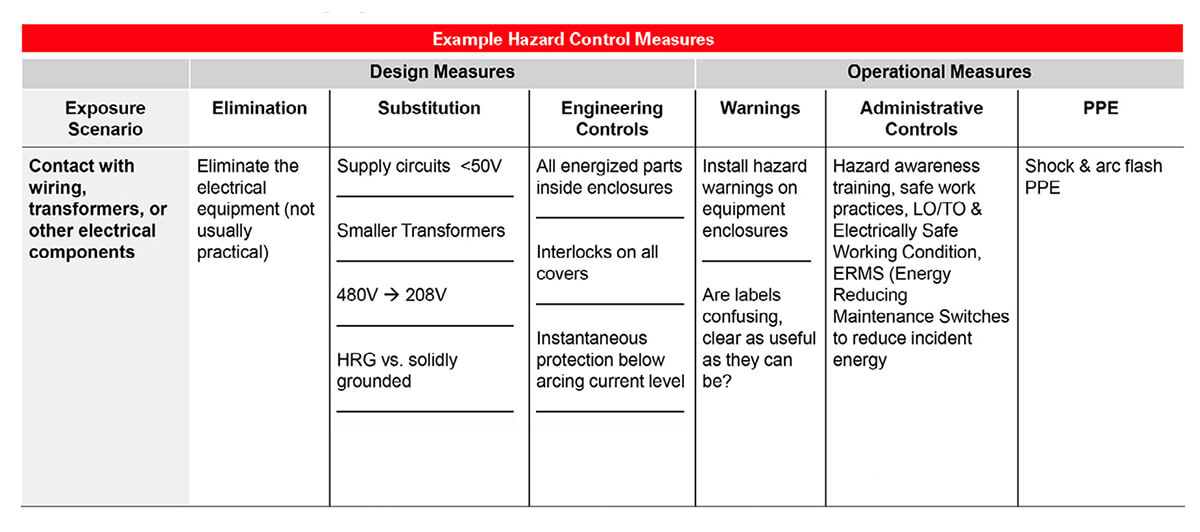
Sponsored by:

WEBINAR EXECUTIVE SUMMARY
WEBINAR EXECUTIVE SUMMARY
Leveraging Prevention Through Design
-
Prevention through design encompasses all efforts to anticipate and design
out worker hazards. - A hierarchy of controls is fundamental to prevention through design.
-
Occupational electrical fatalities in the U.S. have decreased, but more work
needs to be done. - Over the last 50 years, PtD has reduced electrical fatalities.
-
Standards and hazard control measures don’t stand alone; they support each
other. -
Safety, reliability, and productivity are linked—investment in one is often an
investment in the others.
Today’s electrical system designers and facility owners are challenged to comply with the everchanging safety standards and legal requirements enforced nationwide.
These continually updated codes and standards provide more accurate, but more complex, methods of assessing and recognizing hazards. Worker safety is of the utmost importance, whether it is protection from electrical or other common workplace hazards. Prevention through design or PtD is an effective way to reduce electrical danger. This approach has been used successfully for decades to manufacture safer components and systems. Automatic sensing, system layout, and other approaches are proven ways to enhance safety, reliability, and productivity.
Presenters


H. Landis “Lanny” Floyd
PE, CSP, CESCP, Life Fellow IEEE,
Adjunct Professor, Advanced Safety and Engineering Management,
The University of Alabama at Birmingham
Adjunct Professor, Advanced Safety and Engineering Management,
The University of Alabama at Birmingham


Marcelo E Valdes
PE, IEEE Fellow,
Application Engineering Manager,
Marketing, ABB
Application Engineering Manager,
Marketing, ABB
Leveraging Prevention Through Design
In our recent webinar Lanny Floyd and Marcelo Valdes discuss prevention through design and describe how this methodology can improve worker safety, electrical system reliability, and organizational productivity.We’ve summarized the webinar on this page- you can register to view the webinar recording and you can download a PDF summary of the event.
Prevention through design encompasses all efforts to anticipate and design out worker hazards.
The focus of prevention by design (PtD) is on workers who install or maintain different types of systems. Prevention through design isn’t new; its roots are in systems safety which emerged in the late 1930s and early 1940. In the United States, the National Institute of Occupational Safety and Health [NIOSH] launched a formal PtD Initiative in 2006.
Prevention through design focuses on the full life cycle of a product, process, or facility. It begins with the conceptual design and extends all the way to the dismantling or disposal phase of the life cycle. Redesign opportunities also exist throughout the operational phase. They can arise during renovations, expansions or modernizations, incident investigations, or disaster recovery.
Prevention Through Design
Prevention Through Design

Figure 1: Prevention through Design Applies to the Product or Process Life Cycle
Design decisions can reduce electrical risks for the entire life cycle, potentially decreasing worker dependence on safe work practices and personal protective equipment (PPE). PtD reduces the frequency or potential severity of electrical exposures. In some cases, it can eliminate risks entirely.
In 2006, the American Society of Safety Engineers sponsored the development of the ANSI Z590.3-2011 standard – Prevention through Design: Guidelines for Addressing Occupational Hazards and Risk in Design and Redesign Processes. This standard provides a framework, analysis tools, references, and examples. It was revised in 2016.
“As long as there’s a human involved, we’re potentially one mistake away from an error that can cause an incident, an injury, or worst case even a death. If you have a good design, it should take multiple low probability mistakes, and multiple things going wrong, before a bad thing happens.”
– Marcelo Valdes, IEEE Fellow, Application Engineering Manager, Marketing, ABB
A hierarchy of controls is fundamental to prevention through design.
This concept has existed since the early days of system safety. Today, a hierarchy of hazard control measures has been captured in ANSI Z10. Elimination, substitution, and engineering controls can be applied during design and redesign processes. Warnings, administrative controls, and personal protective equipment are applied in the construction, operation, and demolition phases of the project life cycle.
Hierarchy of Controls
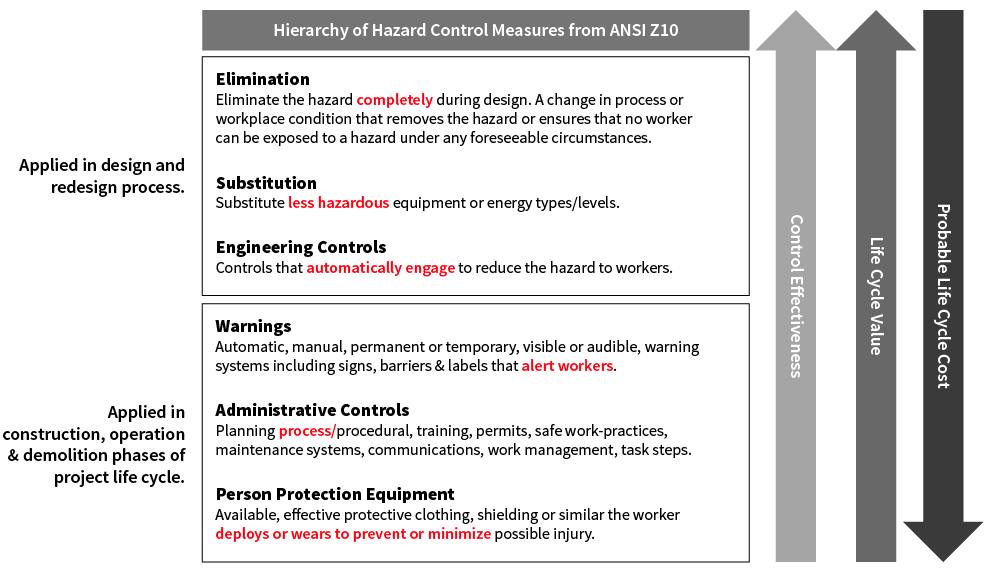
Figure 2: Hierarchy of Controls
Occupational Electrical Fatalities
Between 2004 and 2010, close to half of occupational electrical fatalities involved contact with overhead powerlines.
Occupational electrical fatalities in the U.S. have decreased, but more work needs to be done.
Between 1980 and 2010, the United States experienced a downward trend in occupational electrical fatalities. This is encouraging since the workforce has grown and the amount of electricity used in the workplace has also increased significantly. The decline in fatalities can be attributed to safer electrical equipment designs, safer work practices, better personal protective equipment, and worker education.
Between 2007 and 2016, however, the downward trend in electrical fatalities flattened. This raises the question of what can be done differently. Other countries have demonstrated extraordinary results in reducing electrical fatalities in the workplace. Almost all the Western European countries in the European Union have lower electrical fatality rates than the United States.
Figure 3: The Trend in Electrical Fatalities Has Flattened (2007 – 2016)
Annual Number of Fatal Electrical Injuries at work, 2007-2016
Number of Fatalities
Fatal Electrical Injuries at Work per Million Workers 2007 – 2016
Injuries per Million Workers
Between 2004 and 2010, close to half of occupational electrical fatalities (46%) involved contact with overhead powerlines. Other causes of electrical fatalities included contact with wiring transformers and other electrical components (29%); contact with the current of a machine, tool, appliance, or light fixture (18%); and other accidents (7%). Each of these categories is associated with different types of electrical exposure. This means different PtD-based solutions will be needed to address them.
Over the last 50 years, PtD has reduced electrical fatalities.
Examples of prevention through design include:
- Plugs on electrical cords.Plugs have been redesigned to reduce the likelihood of unintentional contact with the conductive prongs.
- Power tools. Old power tools were often manufactured with conductive metal cases and three wired cords. These cases could become energized due to a failure in the wiring insulation. In addition, if the equipment ground conductor broke, users were subjected to uncontrolled risk. Tools have been redesigned with non-conductive cases and two-wire cords. This is inherently safer because the system doesn’t depend on the equipment ground to protect the person using the tool.
- Electrical outlets. Until 1962, the National Electrical Code requirements focused on two-wire systems. Then the code changed and equipment included a third wire equipment ground.
- Evolution in outlets (cont.). The next evolution in outlet receptacle safety was ground fault circuit interrupter (GFCI) outlets.
- Industrial switchboards. These used to be open devices, with unguarded components, mounted on live front, unenclosed switchboards. All new designs now have enclosed parts and a dead front design. They also have remote control capability and remote diagnostic capability thanks to communication technologies embedded in the equipment.
- Fluorescent lighting ballasts. The National Electrical Code has been updated to require touch-safe disconnect devices.
- Fuse holders. New touch-safe designs meet IP20 requirements for access. They are more effective in reducing the likelihood of a shock during routine maintenance.
- Motor control centers. Historically, people had to dress in PPE such as voltage-ready gloves and arc-flash protected gear when working on motor control centers. Communicating technologies with embedded sensing can reduce worker exposure to hazardous energy.
The hierarchy of controls used in PtD can be applied to many different types of electrical equipment.
The examples below illustrate how the hierarchy can be used for overhead powerlines, cord-powered tools and appliances, and electrical equipment.
Figure 4: Applying the Prevention through Design Hierarchy of Controls
PtD and Overhead Power Lines
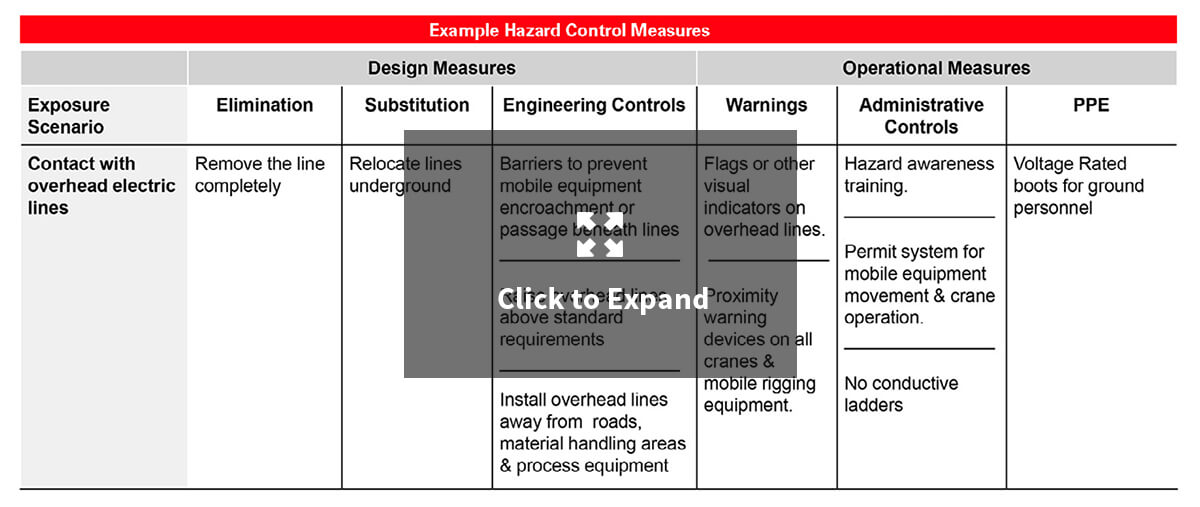
“A Practical Guide for Applying the Hierarchy of Controls to Electrical Hazards”, Floyd, H.I., IEEE Transactions on Industry Applications, Vol. 51, No. 5, September/October 2015.
PtD and Cord Powered Tools and Appliances

PtD and Electrical Equipment
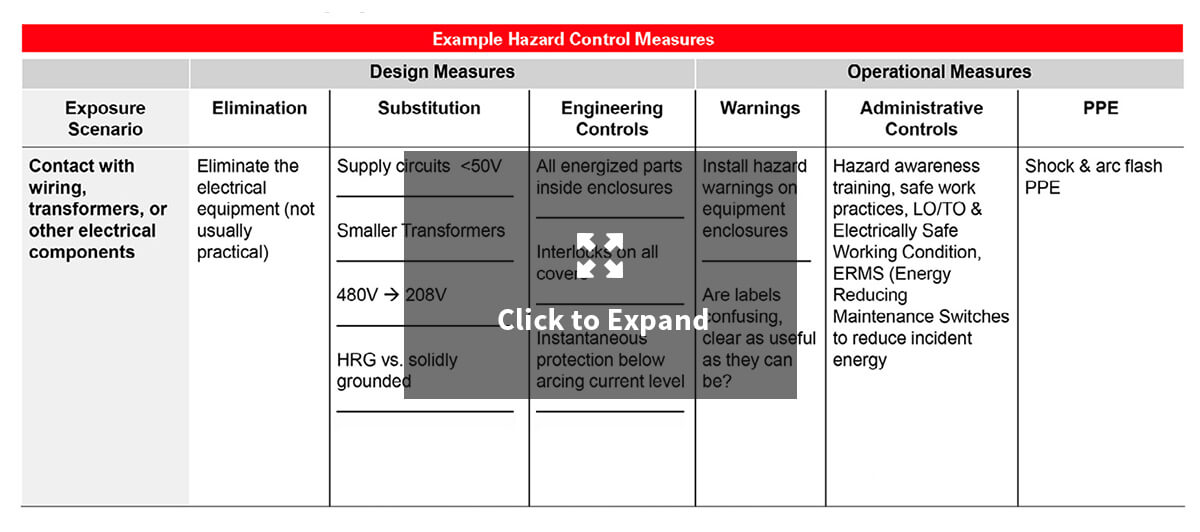
“A Practical Guide for Applying the Hierarchy of Controls to Electrical Hazards”, Floyd, H.I., IEEE Transactions on Industry Applications, Vol. 51, No. 5, September/October 2015.
“Safety and productivity are linked. The more thought and action is invested up front, the more both can be improved in a cost-effective way“
– Lanny Floyd, Life Fellow IEEE, Adjunct Professor, Advanced Safety and Engineering Management, The University of Alabama at Birmingham
Standards and hazard control measures don’t stand alone; they support each other.
Industry safety standards are more than construction minimums; they give guidance on how to prioritize design decisions.
System designers know that NEC compliance is mandatory. However, compliance with 70B and 70E is just as important for workers who live with the equipment. It is important to utilize multiple levels of protection, such as engineering controls, barriers, administrative practices, and PPE.
Safety, reliability, and productivity are linked, investment in one is often an investment in the others.
Observations about electrical safety, system reliability, and company productivity:
- Many types of electrical equipment now include built-in sensors, such as thermal sensors, partial discharge sensors, vibration sensors, and voltage sensors.
- These provide 24/7 sensing which enables teams to shift from calendar-based maintenance to condition-based maintenance.
- Condition-based maintenance minimizes equipment interactions, which is safer for employees. It also reduces the need to shut systems down.
- In large substations, a best practice is to lay out electrical distribution equipment in ways that minimize the effect of shutdowns for maintenance, replacements, and repairs. This is good for safety and also for reliability because it reduces plant shutdowns.
- If a fault occurs, an isolated piece of equipment is easier to replace on a permanent or temporary basis.
- The safety and reliability benefits are interlinked.
- There is little reason to do primary current injection in modern equipment for maintenance purposes. This can cause more damage than intelligent maintenance activity and 24/7 device monitoring.
- Even without human injury involved, an equipment failure is expensive in many ways.
- Equipment failures can be caused by human error.
- The fewer interactions humans have with electrical equipment the better for both the workers and plant productivity.


